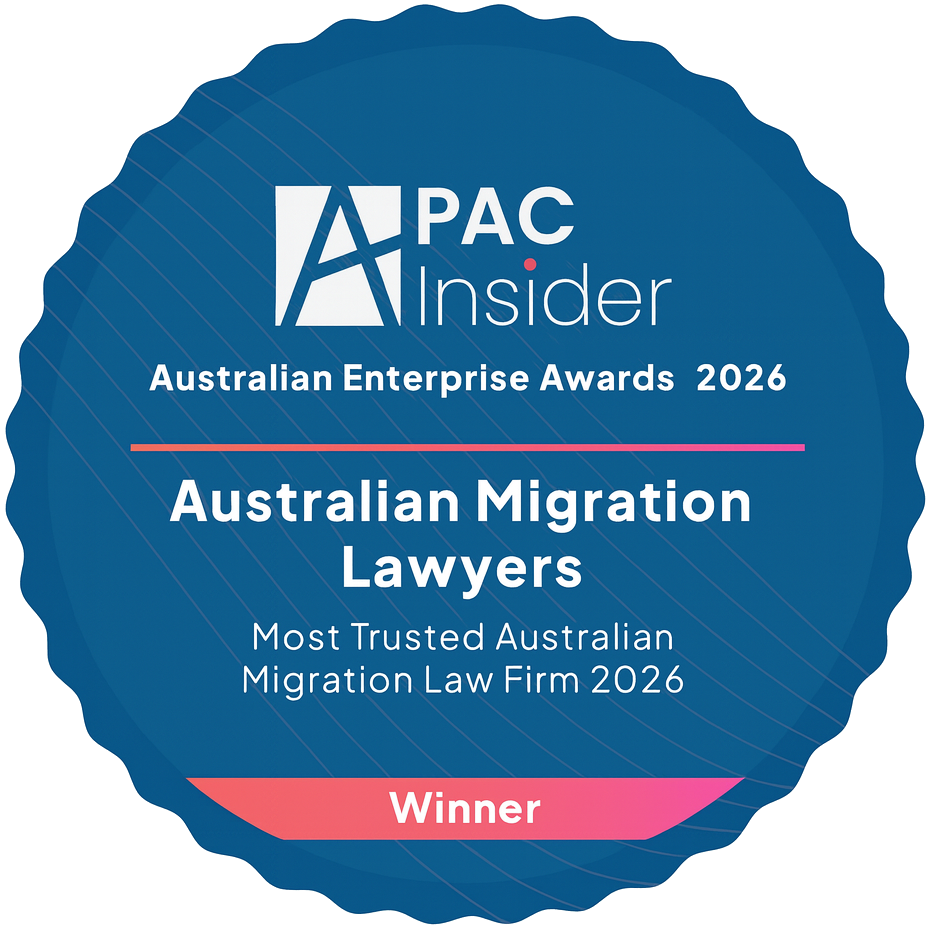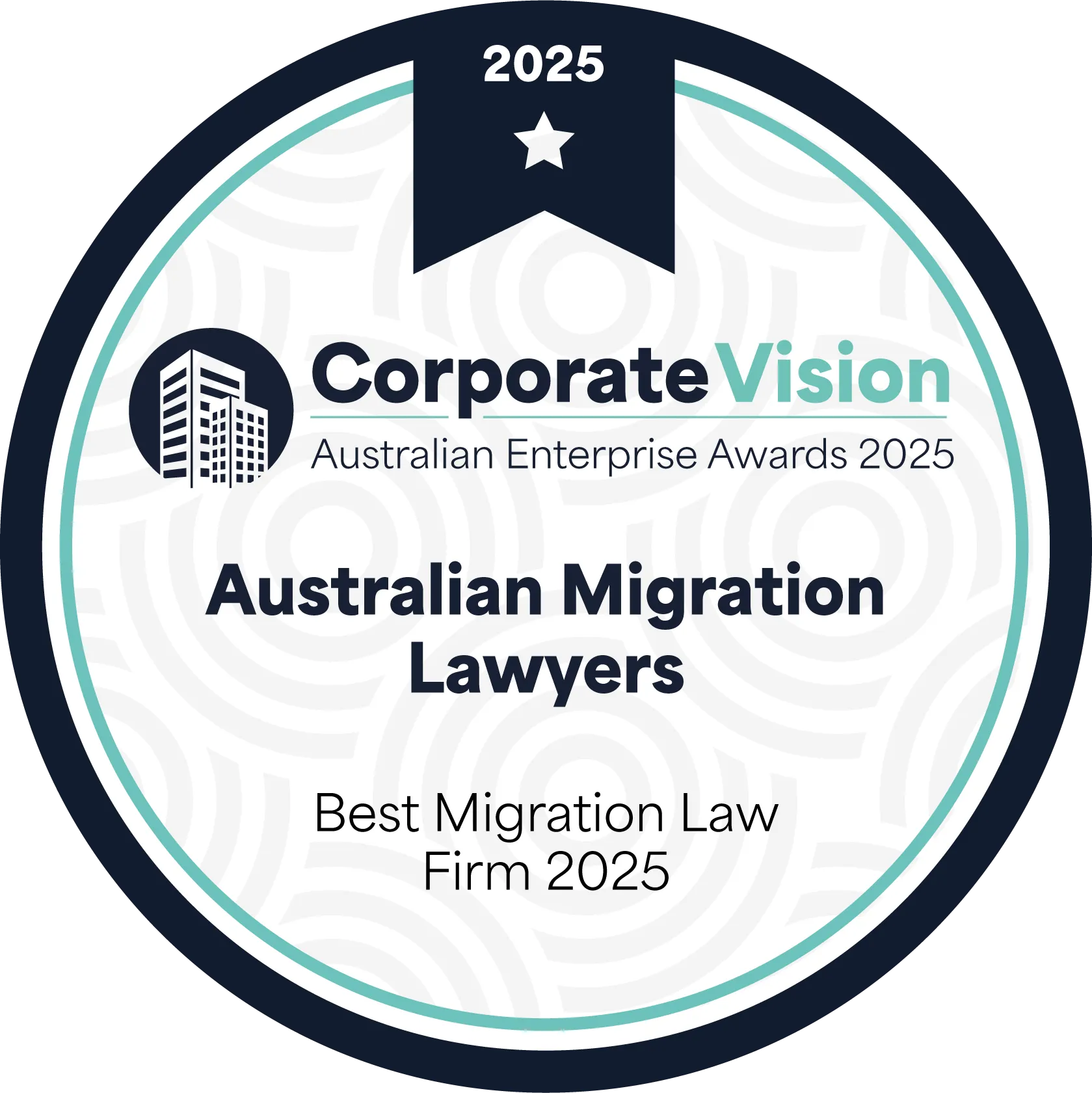澳洲最大的獨立移民法律事務所。開放時間為 7 天!在此預約。
需要協助嗎?我們每週 7 天提供服務。

.webp)

Winner of Most Trusted Australian Migration Law Firm 2023-2026

2023 年、2024 年和 2025 年移民法排名第一

名列 2023、2024 和 2025 年移居律師排行榜前茅

獲評為 2024 & 2025 年最佳移民法律事務所
在岸上申请合作伙伴签证时,一般建议申请人持有当前的实质性签证。然而,根据《1994 年移民法规》(澳大利亚联邦),如果申请人在递交申请时不是实质性签证的持有者(即申请人是非法非公民或过渡性签证的持有者),如果满足 附表 3 的标准,他们仍有资格获得伴侣签证。 如果满足条件,该附表将对申请人提出其伴侣签证申请设定时限。
然而,对于许多潜在申请人来说,附表 3 中规定的标准可能难以满足。不过,根据附表 3,部长有权在确信有令人信服的理由的情况下免除这些标准。
2023 年 2 月 17 日,根據澳洲的資訊自由計劃,澳洲行政上訴審裁處公佈了與在岸夥伴簽證申請相關的迫不得已情況的詮釋和應用指南。
本博文將提供行政上訴審裁處就何時可免除附表 3 要求所提供的資訊摘要。但是,如果申請人需要有關附表 3 情況的具體資訊、量身定制的建議或協助,請立即聯繫澳大利亞移民律師,他們可以代表申請人提供相關資訊和代理。
申請人請注意,2024 年 10 月,澳洲的上訴和審核程序經歷了重大轉變,引入了行政審核審裁庭 (ART),取代了之前的行政上訴審裁庭 (AAT)。這項變革旨在簡化決策流程,並改善申請人尋求移民決定審核的便利性。雖然行政覆核審裁處現在繼續其前身行政上訴審裁處的工作,但行政上訴審裁處提供的資訊仍有助於瞭解涉及附表 3 豁免申請的複雜性。
[免費諮詢]
如果您有兴趣了解有关附表 3 伴侣签证的更多信息,请联系澳大利亚移民律师,进行免费咨询。
[/free_consultation]
根据附表 3,除非得到部长的豁免,否则潜在的岸上合伙人签证申请人将需要
这些要求对任何申请者来说都是难以满足的,因此,申请者往往会试图证明他们有令人信服的情况,不需要满足这些标准。

在《移民法》或《移民条例》中,尽管 "强制 "和 "同情 "这两个词对具体要求的执行至关重要,但它们并没有具体的定义。因此,这需要部长和/或法庭根据上下文逐一考虑,并参考短语使用的背景和短语所在条款的目的。在考虑申请人的情况时,必须考虑到他们的所有情况
使用 "强制 "一词是要求相关决策者出于道义上的需要而要求或迫使其得出特定的结 论。而使用 "同情 "一词,则表示相关决策者对申请人的处境表示同情或怜悯。 虽然这两个词经常一起使用以达到累积效果,但它们并不一定要一起使用,在这种情况下,不应考虑另一个词。因此,在提到 "迫使 "时,情况必须是这样的:决策者被极大地说服而得出某种观点。
因此,在任何特定情况下,相关决策者似乎都必须达到很高的门槛才能放弃附表 3 的要求。
如前所述,如果部长认为有令人信服的理由,则可以免除繁琐的附表 3 标准。
这一豁免的目的是承认申请人可能会遭受一些困难,从而导致申请人在申请伙伴签证时应留在澳大利亚境内,而不是被迫离开。移民部指导决策者考虑申请人在澳大利亚成为非法移民的原因,以及哪些情况是他们无法控制的。 因此,决策者应努力考虑申请人的所有相关情况,包括递交申请时直至做出决定时可获得的信息。只要在做出决定之前存在理由,这些理由就会被视为相关的考虑因素,用于确定是否有令人信服的理由放弃各种标准。
虽然我们认识到,在某些情况下,由于关系的固有特征(如关系持续的时间或关系是否真 实),无法认定存在令人信服的情况,但仍应根据具体情况对申请人的情况进行评估。此外,决策者在评估是否存在令人信服的情况时,应亲自了解情况,并真正考虑所有论点和证据。
决策者在考虑附表 3 豁免的令人信服的理由时,无须考虑国际义务或条约。
归根结底,决策者不应忽视向其提出的确凿理由,并应牢记豁免的目的是避免让特定申请人陷入必须离开澳大利亚才能申请伴侣签证的困境。
正如《移民条例》中所提到的以及法庭所讨论的,没有实质性签证的申请人如果在陆上申请伴侣签证,有可能免除附表 3 的要求。虽然上述信息对任何在申请时可能受附表 3 约束的申请人都有帮助,但澳大利亚移民律师在帮助申请人应对这一复杂的法律情况方面拥有丰富的知识和经验。为确保申请人在申请豁免附表 3 要求时获得最大的成功机会,申请人应联系澳大利亚移民律师,该律师将致力于为申请人提供强有力的支持。
申請人應該聯繫致力於為其提出有力論據的澳洲移民律師,以確保他們在申請豁免附表 3 要求時獲得最大的成功機會。
[aml_difference][/aml_difference]

我們製作了全面的簽證指南,概述了簽證申請的內在和外在。立即索取。